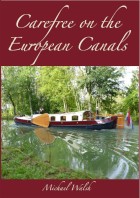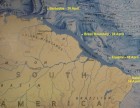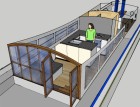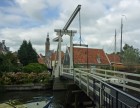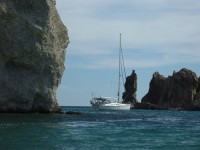Sequitur
Michael & Edi have headed out on a slow, thorough exploration of the globe.
| Vessel Name: | Sequitur and Zonder Zorg |
| Vessel Make/Model: | 2007 Hunter 49 and 1908 Wildschut Skûtsje |
| Hailing Port: | Vancouver, Canada |
| Crew: | Michael Walsh & Edi Gelin |
| About: | For our current location click, on Map & Tracking, then on the Google Earth logo. |
| Extra: | Follow us on Twitter: Follow @YachtSequitur |
| Social: |
13 January 2014
Another New Book Released
I am delighted to announce that my new book: Carefree on the European Canals is now in print and is available on Amazon.com, Amazon.ca [...]
26 April 2013
New Book Released
The proof copy of my new book arrived by courier today. I have approved it and it is now listed on Amazon for pre-order, with a publication date of 30 April. It is a rather large book at 680 pages in an 8.5 by 11 inch format with 315,000 words illustrated by over 2400 colour photos, charts and maps. [...]
24 April 2013
One Year Out of Brazil
One year ago today we sailed Sequitur out of Brazil after enduring more than six weeks in the least-friendly country that we had experienced during our three-year voyage. In the early evening of 24 April 2012 we crossed the line on the chart dividing Brazil from French Guyana and breathed a huge sigh [...]
27 October 2012 | Harlingen, Friesland
Planing a Metamorphosis
We have added a new post to the Zonder Zorg blog at: Planing a Metamorphosis.
29 September 2012 | Sneek, Netherlands
Onward to Friesland
We have arrived in Friesland and have added a new post to the skûtsje's blog at: Onward to Friesland
19 September 2012 | Hoorn, Netherlands
North From Aalsmeer
We have moved northward from Aalsmeer and I have added two new posts: Heading North From Aalsmeer and North From Amsterdam
13 September 2012 | Aalsmeer, Netherlands
Taking Possession
We are back in the Netherlands, and I have added some new posts to the ZonderZorg blog at: Taking Possession and Settling-In and Making Plans
20 August 2012 | Sequitur: St Augustine, USA - Michael & Edi: Vancouver, Canada - Nieuwe Zorg: Aalsmeer, Netherlands
Added a New Website
We have added a new website: Skûtsje ZonderZorg. Zonder zorg in Dutch means without worry. Our intention with the site is to provide a place to share some of the history, geography and culture of the skûtsje as we discover it. We will also use this place to document [...]
11 August 2012 | Sequitur: St Augustine, USA - Michael & Edi: Vancouver, Canada - Nieuwe Zorg: Aalsmeer, Netherlands
Still More Skûtsje History
We continued to attempt to track-down Douwe Albert Visser, who was the owner of Nieuwe Zorg in 1941 when she was re-registered. One of the problems we repeatedly encountered in our online searches was the effect of currently having Albert Visser and two Douwe Vissers as very competitive skûtsje racers, [...]
10 August 2012 | Sequitur: St Augustine, USA - Michael & Edi: Vancouver, Canada - Nieuwe Zorg: Aalsmeer, Netherlands
Some More Skûtsje History
While I was researching the history of Nieuwe Zorg, I finally found her first registration details obscured by an apparent typographical error in a transcribed online spreadsheet. She was listed as having been built in 1901 instead of 1908. I emailed the webmaster of the [...]
To Bahia de Manzanillo
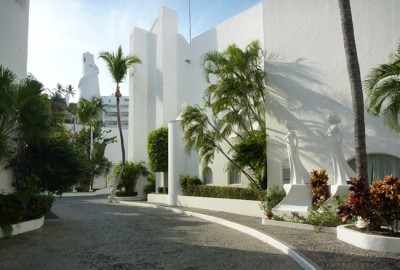
Among my ongoing projects was getting the Fischer-Panda generator working. I had changed the starter relay with the new one Edi had brought back with her from Vancouver, but still had no luck in getting the machine to start. In her wisdom, Edi had picked-up a second new relay while she was there, and my next step was to replace the fuel pump relay with it; I have deduced that they both use the same type. This was on my list for our next anchorage.
As we were exiting Tenacatita Bay, I noted that the alternator seemed to be undercharging. The meters showed that it was making only about 30 amps at 2250 rpm, less than half of what I normally see at that engine speed and a low battery. I had checked the belt while we were in La Manzanilla, and it had been properly tight. Fortunately as we rounded the point at the south of Tenacatita and shaped our course to the southeast, a breeze came up from the west at 6 to 8 knots. I hauled out the sails and shut-down the engine and we sailed along at 3.5 to 4 knots.
The alternator's belt was tight, but its sides were a bit glazed, and there was some black dust on the alternator case, indicating the belt was quickly wearing. Oh goodie! another project for me to work on. I'll have to change the belt when we anchor, but beyond that, I need to determine why the belt was wearing so quickly.

As we sailed a large pod of dolphins crossed our track, and some of them joined us for a while to play in our bow waves.
In the mid-afternoon the winds became fickle and decreased to 3 to 4 knots, mostly from astern, so I flashed-up and we motored in toward Bahia de Manzanillo. As we neared the anchorage, the alternator began acting erratically, and eventually its output dropped to zero.

At 1613 we came to 24 metres on the Rocna in 9.5 metres of water off the marina in Las Hadas. We anchored at a short scope of just over 2.5 to 1 because of the lack of swinging room in the tight crowd of boats in the anchorage.
After we anchored and after I had given the engine a bit of time to cool down so that working in the engine compartment in the 33 degree weather was a bit more bearable, I changed the alternator belt with a new spare. I flashed-up to test it, and saw that the output was still under specifications, but at least it was producing some electricity to help in topping-up the batteries. When I checked it again a quarter hour later, the meter showed that the alternator was no longer charging. I shut down, and decided to let things be for the night.
On Sunday morning I checked the alternator belt; it was properly tight and showed no evidence of slippage. On running, it had an initial low output, then nothing. I guess its 100 amp rating is quite undersized to be able to continuously supply the huge demand I have put on it since the Fischer-Panda generator ceased to work, and I have probably cooked it.
Just to let it know that I'm still thinking of it, I worked on the Fischer-Panda for a while. I replaced the fuel pump relay, bled the fuel system, cleaned the air filter and ran the machine through a few start cycles. Other than my learning a bit more about it, I accomplished little.
We were sitting safely in a wonderful anchorage, and needed to take advantage of it, so I put down my tools, cleaned-up and launched the dinghy. I tested the motor, which had worked well after I had worked on it the previous evening in La Manzanilla. Now it decided to be petulant, and ran intermittently, and then ceased to run at all. I left the motor onboard and rowed into the marina using the hoops of the dinghy's carrying handles as oarlocks. Of course, it was upwind, and yes it was awkward and ungainly, but we eventually got there.

We walked along the private malecon of the Las Hadas complex, which appears to be a combination of resort hotel and condominiums. The architecture is an interesting mix of Moorish, Spanish and modern Pueblo, and the grounds are tastefully landscaped and very well maintained.

Our walk took us to the huge grounds of the All-Suite, All Inclusive Barcelo Karmina Palace Deluxe Hotel. It makes me tired just to say the name of this pompous resort, which according to its literature is of Mayan-style architecture: "The ancient Mayan culture resonates throughout the royal grounds of the resort as a mark of respect for one of the most advanced ancient civilizations in history." We found it very odd to see all the Chinese statuary through the grounds as well as sculptures of Asian elephants in a Burmese or Thai style. Maybe there's more to the Mayan culture than most think.
We walked through the resort grounds, through the hotel lobby and out the road beside the golf course to the main road. There we caught a bus in toward Manzanillo, which took us past some superstores, such as Mega, Walmart and Office Depot. We got off at the Soriana and went in to enjoy the air-conditioning and to buy some fresh fruit and vegetables. From the front of the store we caught a bus, which took us up the narrow winding road along the cliffs of Santiago peninsula, and we walked down through the Las Hadas complex to the marina.
Back onboard, I was again faced with an unwelcome situation. Our water tanks were getting low, and we had insufficient battery remaining to run the watermaker. I still hadn't convinced the generator to work, our engine-driven alternator had packed it in, the sun was sinking behind the hills so the solar panels were done working for the day, and there was no breeze to run the wind generator. We spent the evening onboard rationing both water and electricity use.
With a hacksaw, a file and some emery cloth I converted a stainless steel bolt from the spares bin into a new pin for the dinghy's oarlock, and managed after some prying and wedging to pop it into place. I'm hoping that the difficulty I had in forcing it into place might mean it will be as difficult to come out again. It had come out when we bottomed in a trough just as I had the oar down deeply for a powerful thrust. The oar bottomed on the sand and the weight and momentum of the dinghy did the rest.
On Monday morning our house battery was at 53% and slowly charging as the sun climbed higher. With the nearly flat battery and with the water now down to about 5%, we needed to go alongside and connect to shore power and to fill-up with water. I rowed the dinghy ashore into the marina, an amazingly easier task with the two functioning oarlocks.
We went to the marina office to inquire about moorage. The office was closed; it was just past 1000, and the sign said the office opened at 0900. Apparently we were too early. Edi watched as a boater from a dinghy walked with his computer bag into Freda's Marina Cafe, next to the marina office. She looked in and saw laptop users at the tables. We had brought our computers ashore with us, and we decided to have breakfast at Freda's.
I sent an email reporting on my progress on the generator to James, the Service Manager at Fischer-Panda, and asking him for the next step. I also sent an email to Brad at First Yacht Services in North Vancouver, thanking him for his advice and assistance, and telling him of our problem with the Balmar alternator. Then I started browsing to find information on possible replacements for the alternator.
After a very long breakfast, mostly spent on the Internet, we went back to the marina office and found it open. We arranged to bring Sequitur in at 1600. The marina is all Mediterranean moorage, and the mooring ball for our assigned slip had disappeared, so we would have to drop the anchor and back in on it. We went back out to the boat in the anchorage, where I found that the wifi signal from Freda's was just usable, though a bit intermittent using the antenna.

At 1550 we weighed and headed into the marina and dropped the Rocna about 30 metres in front of the slip and backed in to the 6-metre wide slot between two powerboats taking care not to foul our propeller on their mooring lines. After we were tenuously moored, a swimmer with a snorkel dived on the mooring and eventually found and recovered the line from it. We secured our bow to it and readjusted our stern lines, then I plugged into shore power and filled the water tanks.
Sequitur's wifi antenna worked quite well here to pick-up Freda's connection. I received replies to my emails from both James at Fischer-Panda and Brad at First Yacht Services. James gave me some instructions, which I found a bit complicated, and I tried to decipher them using the Fischer-Panda manual. This proved to be even more confusing; the manual appears to have been translated from the original German through Japanese and Hindi, before arriving at an approximation of English. Brad's suggestion seemed much more straight-forward: Remove the cover from the air filter and spray in some DW40 while initiating the start cycle. This made sense to me, but I decided to put down my tools and manual for the day, and to go at it again in the morning.

For dinner on Monday evening we walked along the waterfront to Los Delfines Restaurant. This is a rather large and elegant palapa standing directly out of the water at the western edge of the anchorage. We were shown to a waterside table and were told they were having a steak festival, which included a choice of various cuts of steak, or a half chicken or grilled dorado fillet, plus a soup bar and a salad bar for 280 Pesos including service. We looked at the soup and salad bars and decided to go for it.
We started with bowls of delicious lobster bisque and then at the salad bar we chose from such things as smoked salmon, marinated beef strips, pecans and a variety of cheeses, in addition to a nice selection of fresh vegetables. We both had the grilled dorado, and I found mine a bit overdone and tough, though very tasty. The wine list's pricing appeared to have a 300% mark-up at the top-end and nearly twice that that at the bottom-end, which started at about 600 Pesos. At close to $50 for a low-quality supermarket wine, we opted for beer. We ordered Corona, and it came so cold that the foam froze as it was poured. We finished with crepes Tatin served with vanilla ice cream.
Throughout dinner we watched the fish swimming in the surging water along the rocky shore beneath our table, and we copied other diners in tossing bread crumbs into the water to attract the fish. As the evening darkened, the restaurant's waterside spotlights attracted even more fish.
On Tuesday morning, I decided to start with Brad's suggestion, and spray WD40 into the Fischer-Panda's air intake. I unbolted the cover and gave a short spray as the engine started cranking. It gave promising sounds on the first starting attempt, so I repeated the process, and the generator started and ran smoothly. I kept it running while I reinstalled the air intake cover and buttoned-up the sound-insulating case. Thanks Brad!
The next task was to see what I could do to replace the alternator. Brad, whose advice on the Fischer-Panda had been spot-on, had suggested I look at a Balmar 95-210 on an AltMount adaptor. I looked at both the Balmar and the AltMount websites to get more information, and then emailed them with questions.
Wanting to ensure that I didn't miss a simple, near-at-hand solution, I asked the marina manager if he knew of any local sources for alternators. He told me the local expert was Electrico El Toques in Santiago. We took a taxi into Santiago for 40 Pesos, and were dropped-off in front of El Toques, which was a street-front workshop, little more than the width of its roll-up door. The largest alternator he had was 100 amps, the size of our current one, which we have found to be much too small.
We caught a bus back, and decided to continue past the exit to Las Hadas and go to the Mega. We cooled-off in the air-conditioning and browsed. I found some fresh shallots, the first we have seen since Moro Bay, California in mid-November, and at only 30 Pesos a kilo, I stocked-up. We also picked-up some fresh tomatoes, tomatillos, cilantro, avocados, bananas, mangos and a big papaya. We had had the foresight to bring our backpacks and one of our insulated bags, so packing the produce back to Las Hadas on the bus was easy.
Because of my rather intermittent and slow sniped wifi connection from Freda's, and Edi's inability to pick-up the signal at all with her computer, we took our computers up to Freda's and ordered couple of Tecates and a dish of guacamole. The dish of nuts that came with the beer, and the guacamole and its corn chips were so filling that we didn't need any dinner. For less than $10 we had a huge guacamole with lots of tostados, a large dish of nuts and two beer, plus secure high-speed internet connections.
On Wednesday morning I started the Fischer-Panda again, just to make sure it was fixed. It started easily the first attempt and ran smoothly, so I let it run and come up to temperature before I shut it down. Next on my list was to resolve the problem with the outboard motor. In my Internet searching, I couldn't find any outboard dealers in the area, other than Mercury, and I long ago learned to avoid that brand. I asked the marina manager if he knew of any, and was told of the possibility of some used ones. He said he would inquire and let me know on Thursday.
Meanwhile, I was going back-and-forth by email with Craig at AltMount, Rich at Balmar and Eddie in the Service Department at Hunter, looking for the best solution for our alternator problem. While waiting for replies, we decided to take the bus into Manzanillo's historic downtown. We discovered a drab, dull and lacklustre place. The church looked more like a warehouse than anything, and we saw very few attractive buildings.

We walked to the waterfront and along to the Armada base. Standing there facing the ships and the base was a bronze statue of a navy helmsman. He had disproportionately short legs and his facial features were very northern European, Germanic or Scandinavian, rather than the expected Spanish or native Mexican features. We could find no explanation.

Rising behind the helmsman was a huge blue stylized sculpture of a marlin with little merit other than its size and the fact that we could see nothing else worthy of a photo. We retraced our steps through the old town to the square and caught the bus back. Because we needed to transfer to the bus to take us to Las Hadas, we decided to do this at the Walmart and to use the opportunity to check it out.

We found some 2008 Gran Tarapaca Chilean Merlot on special, discounted 29 Pesos to 90 Pesos and bought a couple of bottles. We also bought a kilo and a half of basa fillets among other things.
For dinner on Wednesday evening I sauteed the basa in butter with crimini mushrooms, shallots and garlic and added thin tomatillo slices as I cooked the second sides. This was served with basmati rice and asparagus with mayonnaise and accompanied by a wonderful 50 Peso Riesling Qualitatswein from the Rheinpfalz.
On Thursday morning I switched off the shore power and turned on the inverter so that I could monitor Sequitur's electrical system. Next I attacked the outboard motor, and after near fully disassembling it, I found a corroded contact in the throttle switch. Some jiggling and a liberal application of contact spray got it working again. I reassembled the motor and it still worked. With that problem solved, I was down to only the alternator issue to resolve.
Through the day I monitored the state of charge of Sequitur's house bank. It wandered back and forth between 99% and 100% as we used the coffee maker, the toaster, the kettle, our computers and various other ac and dc loads through the day. Once the sun went behind the ridge above us around 1700, and with no wind and no shore power, the charge in the house bank started dropping as we continued our liberal use of electricity. By 2200 the battery was down to 91%, so I flashed-up the Fischer-Panda and watched as it did a short bulk charge run at 170 to 180 amps, then tailed off to a float charge at around 75 amps. I ran it until the batteries were back up to 93% and shut it down, satisfied that it was performing properly. I switched on the shore power to continue the charging a bit more quietly.
On Friday afternoon we moved back out to the anchorage to await the new alternators, regulators, sensors and mounting kits.

